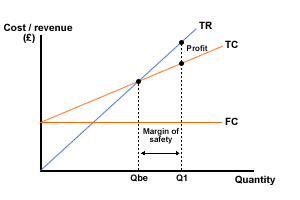Margin of safety
The aim of most firms is to make a profit. Consequently the objective is to operate at a position as far to the right of the break-even quantity as possible - i.e. to produce and sell as many products as the firm can produce using its existing resources.
Having established the break-even quantity, therefore, the next step is normally to compare the BEQ to where the firm is actually producing. If it is above the break-even point, it will be making a profit and the firm is in a safe position as a result. How safe it is will depend on how far above the break-even point it is - the more the better as it improves its margin of safety.

Margin of safety
The margin of safety is the difference between the planned or actual level of production/sales and the break-even quantity. Firms will seek to maximise their margin of safety as this will maximise their potential profit.
Of course if a firm is producing below the break-even point it will be making a loss and there is no safety margin.
The margin of safety can be shown on a break.-even chart - see figure 1 below.

Figure 1 Margin of safety

Follow the links below to see some examples of the margin of safety:
Example 1 - Magnum Motors
Example 2 - River Craft
Example 3 - River Craft (2)
Remember:
- The margin of safety can be negative. This means there is a loss situation.
- Results based on forecast data will often be higher than achieved in reality. Forecasts of sales, made by marketing staff, tend to be too high while estimates of cost, made by development or production personnel, will often be too low.
- Margin of safety is usually expressed as a number, but this can hide useful information. Which is best, or safest, Example 2 or 3? It looks like 2, with the highest number. Express the figure as a % of BEQ, and a different picture is revealed.
- Margin of safety for 'Example 2' is 14%, but for 'Example 3' is 230%. '2' is much riskier, therefore.
Margin of safety has little value in relation to actual production and sales, the firm already knows that it is making a loss or not. It has value, however, as a planning tool as it shows risk, and should be included as part of the decision making process.
